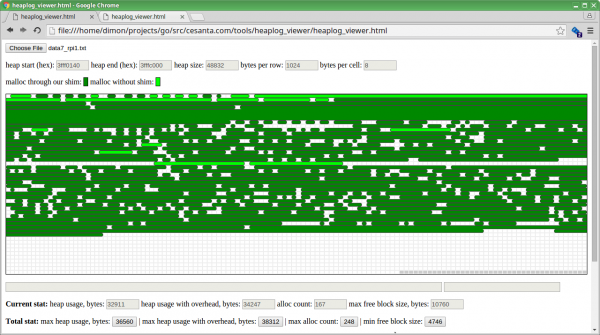In C
Just think malloc and free. Literally you managing the memory at runtime.
Definition
Refers to the algorithms for allocating and deallocating objects of a variable size in memory at program execution time (hence the “dynamic”)
Types of Management
Explicit Memory Management
The application is responsible for freeing allocated memory
- E.g,
mallocandfreein C,newanddeletein C++
Implicit Memory Management
Garbage collection
Block Diagram
- The application interacts with the allocator, which is part of the language run time environment
- At the back end, the allocator relies on certain OS services
Allocator Efficiency
Time Efficiency: Maximize throughput (# of requests per unit time)
Space Efficiency: Maximize memory utilization, or, equivalently, minimize overhead or wasted space
- In general, when the application calls the allocator for bytes, the allocator responds with a pointer to a block of size bytes, so the overhead is bytes
- Overhead is for metadata
How the Allocator “See’s” it
At any instant of time, the allocator has some memory it has obtained from the OS via sbrk() calls
- This space is called the pool or arena
The memory is then broken up, aka fragmented, into variable-sized blocks of two types:
- An allocated block is one that has been given to a mutator already, so it cannot be used again
freeis called - A free block is one that hasn’t yet been allocated, it can be used by
malloc.

(Source: https://dmitryfrank.com/articles/heap_on_embedded_devices)
Design of malloc and free
void *malloc(size_t n) {
m = realSize(n); // including metadata + n
// find free block B with size >= m
// if there is no block, call sbrk()
if(!block) {
sbrk();
}
// split the memory block to size
// move the part that is for user to allocated pile
// add the other part of memory (the extra) to the free block heap/pile
return piece; // the allocated part
}void free(void *p) {
// validate the block with its stored metadata
// move block from allocated pile to free pile
// coalesce (make it one big block to stop fragmentation)
}The free memory is stored as a linked list.
Free list management
There are five key concerns when designing a memory manager using free list management:
- Format: what free and allocated blocks should look like; how the metadata for each block is stored.
- Organization: How tho keep track of all the free blocks.
- Selection: How to pick and appropriate free block for the current request.
- Splitting: What to do with the remainder of a free block after allocation.
- Coalescing: How to handle a block that is being returned to the free list.
Problems with handling the ‘linked list’
The memory is stored as a ‘linked list’, but how does that work if we don’t have a valid place to put the list into memory? How do we store it?
The metadata of the blocks.
Designing Memory Blocks
Free list organization
How can we keep track of the free blocks? Well, we can make a singular linked list (can be singly- or doubly-linked, null terminated or circular).
Each decision has specific implications to be considered.
- Implicit or Explicit methods for organization
- Combined or binned
- Returns blocks maintained in LIFO (Last in first out, e.g., stacks), address-sorted (easiest!! do this one!!), or size-sorted order